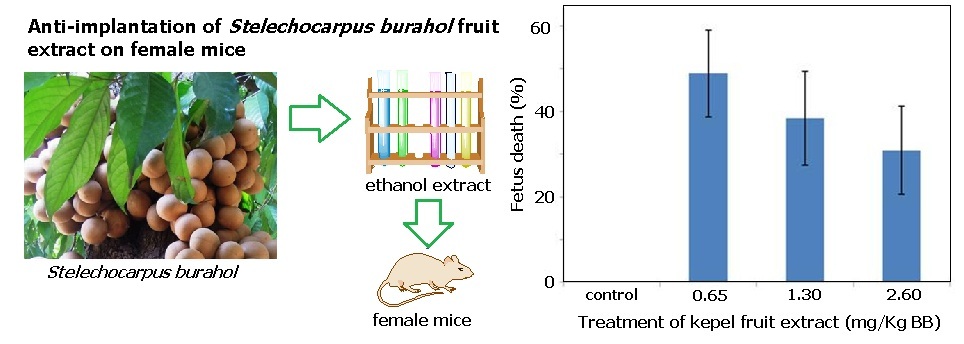Anti-Implantation Activity of Kepel (Stelechocarpus burahol) Pulp Ethanol Extract in Female Mice
Abstract

Kepel (Stelechocarpus burahol) has been used as a contraceptive remedy in Indonesia traditional Javanese royal family. It fruit contains a toxic substances to fetus. However, few studies have been conducted on the toxic effect of kepel fruit. This paper is disclosed the effect of kepel’s fruit extract on the percentage of fetus death, ovaries weight, and endometrial thickness in female mice. This study applied a post-test control group design. A 28 female of mice were divided into 4 groups. Group I (control), II, III, and IV were groups treated with kepel pulp extract using dosage 0.65, 1.30, and 3.60 mg/kg body weight (BB). The extract was dissolved in DMSO and given in 1.0 mL/mouse. The result gives implantation numbers of each group I-VI were 5.60±1.14; 6.20±1.64; 7.60±1.51; and 8.00±1.58, respectively. The percentages of fetus death 0.00%±0.00; 48.89%±22.78; 35.83%±25.27; and 30.87%±23.01 and fetus re-sorption in all groups were recorded as 0.00±0.00. Moreover, the ovaries weight of each groups I, II, III, and IV were recorded in 0.11±0.01; 0.08±0.01; 0.11±0.32; and 0.07±0.02 g, respectively. In addition, endometrial thickness were calculated as 584.86; 841.68; 659.72; and 624.10 µm. The anova test showed that insignificant difference for ovaries weight and endometrial thickness both for control and treated groups. Conversely, the LSD test showed the percentage of fetus death has a significant difference between control and treatment groups. These result suggest that kepel pulp ethanol extract has potency for anti-implantation.
References
SIBURIAN, J.; MARLINZA, R. 2009, Bioscience, 2009, 2(2), 24-30. [2] Manuaba, I.B.G., Kapita Selekta Penatalksanaan Rutin Obstetri Ginekologi dan KB, Edisi 1, 2001. EGC, Jakarta, [3] VERHEIJ, E. W. M.; CARONEL, R. E. Sumber Daya Nabati Asia Tenggara, 1997, Gramedia, Jakarta, [4] Purwantiningsih, A.R. Hakim, Efek Hipourikemia Ekstrak Daun Kepel (Stelechocarpus burahol (bl.) hook.f. & th.) terhadap Allopurinol secara in vivo. 2009, Fakultas Farmasi Universitas Gadjah Mada, Yogyakarta, [5] Darusman, HS., Aktivitas Farmakologis Tanaman Kepel (Stelechocarpus burahol (Blume) Hook & Thompson) sebagai Deodoran Topikal dan Oral, Thesis, 2010, Bogor, Fakultas Kedoktean Hewan Institut Pertanian Bogor. [6] Sunardi, C., Jurnal Tumbuhan Obat Indonesia, 2010, 3(2), 115-117. [7] Sundari D., L. Widowati, B. Wahjoedi, dan M.W. Winarno, Penelitian Tanaman Obat di beberapa Perguruan Tinggi di Indonesia X, Pusat Penelitian dan Pengembangan Farmasi, 2000, Badan Penelitian dan Pengembangan Kesehatan Departemen Kesehatan RI, Jakarta. [8] Cahyadi, R., Uji toksisitas akut ekstrak etanol buah pare terhadap larva Artemia salina Leach dengan metode Shrimp Lethality Test, Skripsi, 2009, Fakultas Kedoktean Universitas Diponegoro Semarang. [9] Meiyanto, E., Ratna, Handayai, and Fitriarahmi, Majalah Farmasi Indonesia, 2008, 19(2), 12-19 [10] Guyton, A.C., Fisiologi Manusia Dan Mekanisme Penyakit, Edisi 11, 2007, Penerjemah Petrus Andriyanto, EGC, Jakarta, 1065-1073. [11] PACIFICI, Gian Maria; NOTTOLI, Rita, Clin. Pharmacokinet., 1995, 28, 235-304. [12] Goldstein, A., Aronow, Kalman, Principle of Drugs Action, Edisi 2, 1974, Willey Biomedical Health Publishing, New York. [13] Siburian, J., J. Marina, dan A. Johari, Biospecies, 2008, 1(1), 1-5. [14] Suherman, S.K., Estron, antiestrogen, progestin dan kontrasepsi oral dalam farmakologi dan terapi, 5th edition, 2007, Departemen farmakologi dan terapeutik. Fakultas Kedokteran Universitas Indonesia. [15] Achdiat, C.M., Fitoestrogen untuk wanita menopause in http://www.situs. kesrepro.info/aging/jul/2003/ag01. Visited at 30 November 2007. [16] Tsourounis C., Clin. Obstet. Gynecol., 2001, 44 (4), 836-842. [17] SANI, U. M.; SULE, M. I., Nig. J. Pharma. Sci., 2007, 6(2), 78-83. [18] Campbell, N.A., J. Recce, dan L.G. Mitchell, Biology, Edisi 5, Jilid 3, 2004, Erlangga, Jakarta, 162-175. [19] SITASIWI, Agung Janika, Jurnal Anatomi Fisiologi, 2008, 16, 2, 38-45. [20] Lukitaningsih, Endang. Fitoestrogen Senyawa Alami Yang Aman Sebagai Pengganti Hormon Estrogen Pada Wanita. 2013, accessed from http://mipto.farmasi.ugm.ac.id/review-penelitian-161-fitoestrogen--senyawa-alami-yang-aman-sebagai-pengganti-hormon-estrogen-pada-wanita.html date 15 Dec. 2015 [21] Hikmah, Rusmiati, dan H.B. Santoso, Bioscientiae, 2009, 6(2), 11-15.
Refbacks
- There are currently no refbacks.









